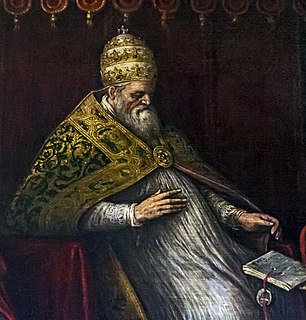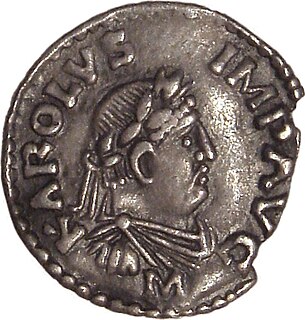See also
| This Holy Roman Empire–related article is a stub. You can help Wikipedia by expanding it. |
The Treaty of Ceprano was signed in Ceprano on August 1230 between Pope Gregory IX and Holy Roman Emperor Frederick II. Based on the terms of the accord, Frederick agreed not to violate any territories held by the Papacy. In return for Frederick's concessions in Sicily, the Pope removed his sentence of excommunication. Overall, the treaty helped to establish lines of reconciliation between the Holy Roman Empire and the Roman Catholic Church.
| This Holy Roman Empire–related article is a stub. You can help Wikipedia by expanding it. |

The Holy See, also called the See of Rome, is the jurisdiction of the Bishop of Rome, known as the pope, which includes the apostolic episcopal see of the Diocese of Rome with universal ecclesiastical jurisdiction of the worldwide Catholic Church, as well as a sovereign entity of international law.

The Peace of Westphalia was a series of peace treaties which were signed between May and October 1648 in the Westphalian cities of Osnabrück and Münster, largely ending the European wars of religion, including the Thirty Years' War. The treaties of Westphalia brought to an end a calamitous period of European history which caused the deaths of approximately eight million people. Scholars have identified Westphalia as the beginning of the modern international system, based on the concept of Westphalian sovereignty, though this interpretation has been challenged.

Pope Honorius III, born as Cencio Savelli, was the 177th Pope of the Catholic Church and ruler of the Papal States from 18 July 1216 to his death in 1227.

Pope Clement III, born PaulinoScolari, was the pope from 19 December 1187 to his death.
The Roman Curia comprises the administrative institutions of the Holy See and the central body through which the affairs of the Catholic Church are conducted. It acts in the Pope's name and with his authority for the good and for the service of the particular churches and provides the central organization for the church to advance its objectives.

Pope Lucius II, born Gherardo Caccianemici dal Orso, was head of the Catholic Church and ruler of the Papal States from 9 March 1144 to his death in 1145. His pontificate was notable for the unrest in Rome associated with the Commune of Rome and its attempts to wrest control of the city from the papacy.

The Holy Roman Emperor, officially the Emperor of the Romans, and also the German-Roman Emperor, was the ruler of the Holy Roman Empire. The Empire was considered by the Roman Catholic Church to be the legal successor of the Roman Empire during the Middle Ages and the early modern period. The title was, almost without interruption, held in conjunction with title of King of Germany throughout the 12th to 18th centuries.

Frederick II was King of Sicily from 1198, King of Germany from 1212, King of Italy and Holy Roman Emperor from 1220 and King of Jerusalem from 1225. He was the son of emperor Henry VI of the Hohenstaufen dynasty and of Constance, heiress to the Norman kings of Sicily.
The Lateran Treaty was one component agreement that made up the Lateran Pacts of 1929, the agreements made in 1929 between the Kingdom of Italy and the Holy See settling the "Roman Question". The treaty and associated pacts are named after the Lateran Palace, where they were signed on 11 February 1929. The Italian parliament ratified them on 7 June 1929. The Lateran Treaty recognized Vatican City as an independent state under the sovereignty of the Holy See. The Italian government, at the time led by Benito Mussolini as prime minister, also agreed to give the Roman Catholic Church financial compensation for the loss of the Papal States. In 1947, the Lateran Treaty was recognized in the Constitution of Italy as regulating the relations between the state and the Catholic Church.

The Archbishopric of Magdeburg was a Roman Catholic archdiocese (969–1552) and Prince-Archbishopric (1180–1680) of the Holy Roman Empire centered on the city of Magdeburg on the Elbe River.

The Catholic League was a coalition of Catholic states of the Holy Roman Empire formed 10 July 1609. While initially formed as a confederation to act politically to negotiate issues vis-à-vis the Protestant Union, modelled on the more intransigent ultra-Catholic French Catholic League (1576), it was subsequently concluded as a military alliance "for the defence of the Catholic religion and peace within the Empire".

The Guelphs and Ghibellines were factions supporting the Pope and the Holy Roman Emperor, respectively, in the Italian city-states of central and northern Italy. During the 12th and 13th centuries, rivalry between these two parties formed a particularly important aspect of the internal politics of medieval Italy. The struggle for power between the Papacy and the Holy Roman Empire had arisen with the Investiture Controversy, which began in 1075 and ended with the Concordat of Worms in 1122. The division between the Guelphs and Ghibellines in Italy, fuelled by the imperial Great Interregnum, persisted until the 15th century.
The Treaty of San Germano was signed on July 20, 1225 at San Germano, present day Cassino, between Holy Roman Emperor Frederick II and Pope Honorius III. A Dominican named Guala was responsible for the negotiations.
The Treaty of Ceprano may refer to:
A treaty of the Holy See is called a Concordat. This is a list.
The Princes' Concordat was an agreement concluded in January 1447 between Pope Eugenius IV and the prince-electors of the Holy Roman Empire. It outlined generous concessions on the part of the Pope, particularly covering the appointment of Church positions, in exchange for the support of the German princes.

The Peace Treaty of Wiener Neustadt was a treaty between the Kingdom of Hungary and the Holy Roman Empire. It was preceded by the Truce of Radkersburg and followed by the Peace of Pressburg. It deals with succession issues and ascertains the territory mortgages in Moson, Sopron and Vas counties.

Georgia – Holy See relations are bilateral relations between Georgia and the Holy See. The diplomatic relations between the two were established on May 5, 1992. The Georgian Embassy to the Holy See is located in 25 Via Toscana, Rome. The Apostolic Nunciature is located in 40 Zghenti Street, Tbilisi.

Bulgaria–Holy See relations were formally established only in 1990, shortly after the fall of the Bulgarian communist government. Since then, Bulgaria and the Holy See have had an increase in relations, with Pope John Paul II visiting the country in 2002, and more recently visits from Secretary of State Angelo Sodano (2005) and Pietro Parolin (2016).